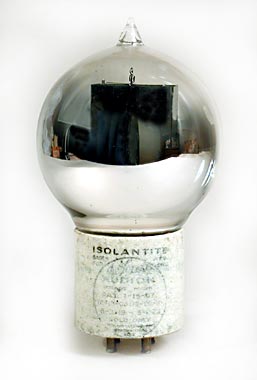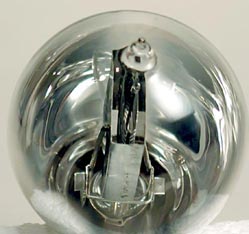|
 
The DV-9 low power transmitting triode 1926. The DV-9 was intended for transmitting use only and has a somewhat different internal design than the later DL-9. This tube was made only briefly before being replaced by the Type D transmitting tube.
While most valve/tube collectors are familiar with the De Forest DV-DL series of tubes, the DV-9 is one member of the family unknown to most and seen by very few. The main reasons for its obscurity are the almost complete lack of advertising and the fact that it was replaced by another De Forest tube less than a year after its introduction. The only known advert for the DV-9 was in an announcement in QST magazine for July of 1926. This advert gave little information, simply stating that the DV-9 was a low power transmitting tube for short waves. The price was given as $9.00. There is no picture, only a fairly crude line drawing which shows the spherical bulb but does not show the tip. Also listed in this same advert was the DV-9R rectifier, a tube even more obscure than the DV-9. There is no drawing, only a description which states that the DV-9R is similar in design to the De Forest HR rectifier, only intended for lower power. Recently a tube was seen that appears to be a DV-9R. This tube closely resembles the DV-9 with the grid omitted, and like the DV-9 has no marking.
As shown in the above image, the DV-9 has a spherical bulb about 57 mm in diameter, and an overall height of just over 100 mm. There is no marking on the tube, other than the standard info on the base. There may have been a paper label at one time, however the few other known examples of tubes that fit the DV-9 description were also without marking. The other examples were also heavily gettered such that the internal structure could not be observed. Also seen above is a close-up of the internal construction. The large box plate and centre spring loaded filament support give this tube the look of a scaled down Singer power valve.
The advert gave no operating data of any kind, but by various empirical methods it was determined that the filament voltage was 7.5 Volts, at which condition the filament drew 1.0 Amp. The input power is estimated to be about 15 Watts. Note that this tube is not an early version of the DL-9. The DL-9 was strictly an audio amplifier with a different design and not interchangeable. In 1927 the more familiar type D transmitting tube was released and apparently replaced the DV-9. The D had a larger pear shaped bulb and a filament that drew 2.0 Amps at 7.5 Volts. A companion rectifier to the D, the DR, was most likely the replacement for the DV-9R.
|